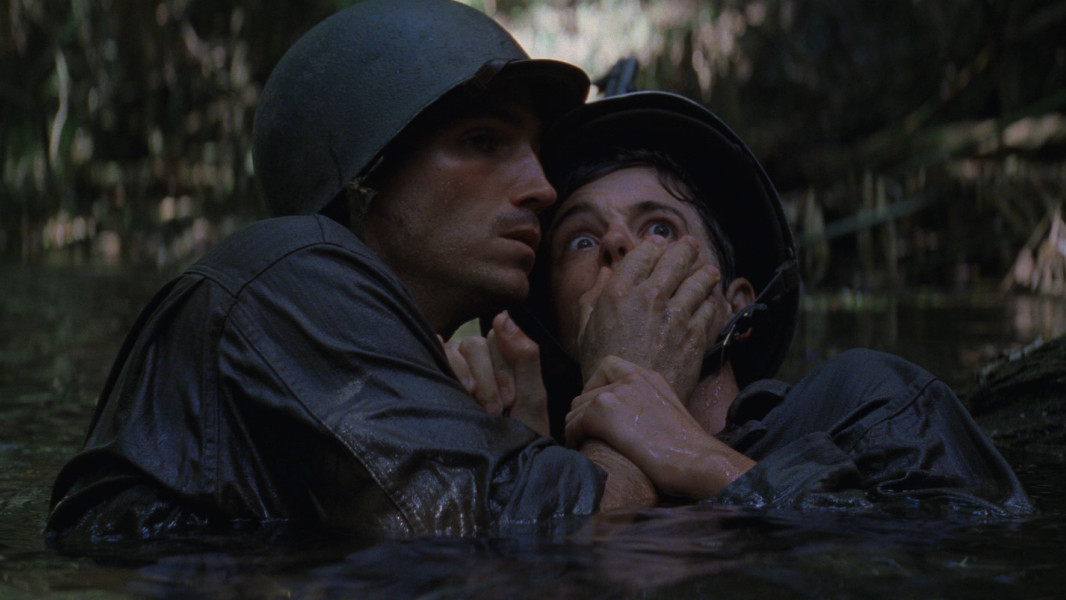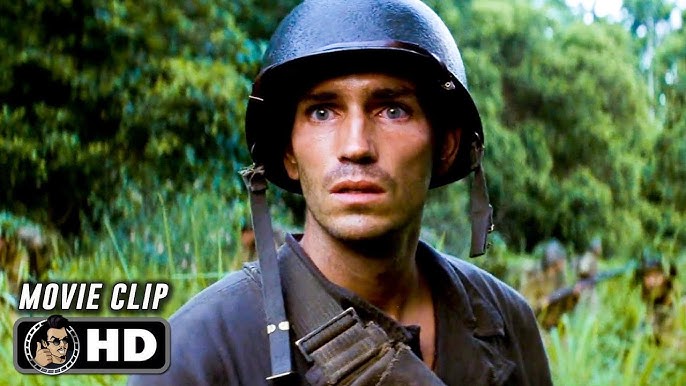🎬 The Thin Red Line (1998): A Poetic Meditation on War and Humanity
- movies
- October 24, 2024

The Thin Red Line (1998), directed by Terrence Malick, is a visually stunning and philosophically profound war film that reimagines the traditional war genre by delving into the inner lives of soldiers and the stark beauty of the natural world. Set during World War II, the film focuses on the Battle of Guadalcanal in the Pacific theater, yet its real subject is the human experience in the face of war, nature, and mortality. With its ensemble cast, reflective narration, and meditative tone, The Thin Red Line stands out as a war film that challenges conventional depictions of conflict and heroism.
Plot Overview:
The film is loosely based on the semi-autobiographical novel by James Jones and follows a group of American soldiers in C Company as they engage in the brutal and bloody Battle of Guadalcanal. Rather than focusing on a single protagonist, The Thin Red Line uses multiple perspectives, exploring the lives and thoughts of several soldiers as they confront the horrors of war, their own mortality, and their place in the world.
At the center of the story is Private Witt (Jim Caviezel), a soldier who has gone AWOL and is living peacefully among the indigenous people of a remote Pacific island. He is soon found and returned to the front lines by his superior, First Sergeant Welsh (Sean Penn), a cynical and hardened soldier who sees war as pointless and devoid of meaning. As C Company is thrown into the chaotic battle for control of a key ridge, the soldiers—each with their own personal struggles—must navigate the brutality of combat and the existential questions that arise in the midst of it.
Colonel Tall (Nick Nolte) is the commanding officer, obsessed with proving himself and gaining glory in battle, while Captain Staros (Elias Koteas), a more compassionate officer, is torn between following orders and protecting his men. As the film unfolds, the soldiers’ personal reflections and inner turmoil take center stage, overshadowing the traditional war film narrative of action and strategy.

Character Development and Themes:
One of the defining features of The Thin Red Line is its use of an ensemble cast, which includes notable actors such as John Cusack, Woody Harrelson, John C. Reilly, George Clooney, and Adrien Brody, among others. However, the characters are not traditional war movie heroes; instead, they are often portrayed as introspective, fragile, and deeply affected by the violence around them.
Jim Caviezel’s Private Witt is the film’s spiritual center, offering a contrast to the other soldiers who are more hardened by the war. Witt’s philosophical outlook and quest for meaning in life, even amid chaos, make him a central figure in the film’s exploration of humanity’s place in the natural world. His relationship with Sergeant Welsh, played by Sean Penn, serves as a philosophical debate between optimism and cynicism. Welsh’s disillusionment with the world stands in stark contrast to Witt’s belief in the possibility of finding beauty and peace, even in the most violent of circumstances.
Nick Nolte’s Colonel Tall is a portrayal of ambition and the dehumanizing effects of war on leadership. His desire for victory and recognition blinds him to the suffering of his men, creating tension between him and Captain Staros, whose empathy for the soldiers under his command makes him reluctant to follow orders that would result in needless casualties.
One of the most prominent themes of The Thin Red Line is the juxtaposition between nature and war. Malick’s direction emphasizes the beauty of the natural world—the lush, untouched landscapes of the Pacific islands—against the horrors of human conflict. This contrast serves as a reminder of the smallness of human life in the grand scheme of the natural world, as well as the senseless destruction that war brings to both nature and humanity.

The film is also a meditation on mortality and the search for meaning. Through the soldiers’ internal monologues and quiet reflections, The Thin Red Line asks deep, existential questions: What is the purpose of war? How do individuals maintain their humanity in the face of unimaginable violence? What does it mean to live and die in a world that seems indifferent to human suffering? These philosophical themes make the film less about the specifics of the Battle of Guadalcanal and more about the universal human experience in times of conflict.
Action and Visual Style:
While The Thin Red Line is a war film, its approach to combat is far from typical. Rather than glorifying battle or focusing on military strategy, the film presents war as chaotic, terrifying, and deeply personal. The action sequences, particularly the harrowing assault on the ridge, are filmed in a way that emphasizes the disorientation and fear of the soldiers. There are moments of intense violence, but Malick often cuts away from the brutality to show the natural world—waves crashing on the shore, birds soaring in the sky—creating a stark contrast between the beauty of nature and the destruction of war.
Cinematographer John Toll’s work is a highlight of the film, capturing the stunning landscapes of the Pacific islands in a way that feels almost dreamlike. The camera lingers on the details of the environment—sunlight filtering through the trees, the movement of the wind through the grass—creating a sense of calm amid the chaos. These visual moments are often accompanied by voiceover narration from various characters, reflecting on their fears, hopes, and philosophies.

Hans Zimmer’s haunting score is another key element of the film’s atmosphere. The music, with its ethereal and melancholic tones, enhances the introspective mood of the film, underscoring the emotional weight of the soldiers’ experiences without resorting to bombastic or overly dramatic cues.
Criticism:
The Thin Red Line received widespread critical acclaim for its visual beauty and philosophical depth, but it was also divisive due to its unconventional structure and pacing. The film’s narrative is fragmented, with little emphasis on traditional plot development. Instead, the story unfolds through a series of vignettes, interspersed with internal monologues that can feel disjointed or slow-paced to some viewers.
Additionally, the lack of a single protagonist or clear resolution may frustrate audiences looking for a more straightforward war film. The film’s focus on the internal lives of the characters, rather than the external events of the battle, makes it a more meditative and abstract experience than many other war films.

Final Thoughts:
The Thin Red Line is a unique and ambitious war film that transcends the conventions of the genre. With its stunning cinematography, philosophical reflections, and ensemble cast, the film offers a profound exploration of war, nature, and the human condition. Terrence Malick’s direction invites viewers to reflect on the meaning of life, death, and conflict, making The Thin Red Line a deeply personal and thought-provoking experience.
For those seeking a war film that challenges traditional storytelling and offers a more introspective, poetic take on the human experience, The Thin Red Line is a cinematic masterpiece that lingers long after the credits roll.
Movie Information:
- Title: The Thin Red Line
- Director: Terrence Malick
- Starring: Jim Caviezel, Sean Penn, Nick Nolte, Elias Koteas, Ben Chaplin, John Cusack
- Genre: War, Drama, Philosophical
- Release Date: December 25, 1998
- Running Time: 170 minutes
- Rating: R
- Plot Summary: A group of American soldiers fight in the Battle of Guadalcanal during World War II, but the true focus of the story lies in their internal struggles as they confront the horrors of war and the beauty of the natural world around them. Through their reflections and experiences, the film explores deep philosophical questions about life, death, and humanity.
SUGGESTED VIDEO FOR YOU:
[Movie Review] Legend of Retired Cop Against Drug Empire || The Last Stand
[Movie Review] Survival War In The 333-Story Vertical Prison || The Platform 2










